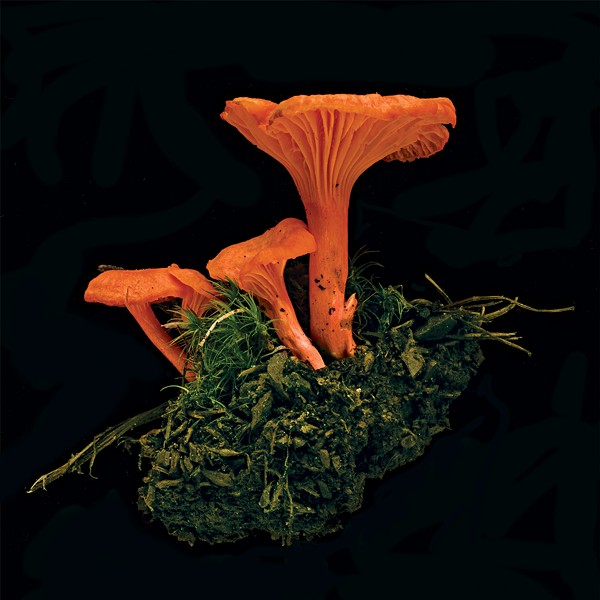Their marble pillars overswelling,
And danger paused to pluck the flowers
That in their swarthy rings were dwelling.
Those lines, by the English “peasant poet” John Clare, may be the one literary allusion to mushrooms that has somehow escaped Frank Spinelli in this glorious book of large, vivid photographs and equally enticing prose. From his forays into the “forests, rocks and open fields” that fringe his home in the Catskills, Spinelli has laden these pages with a trove of toadstools, a cornucopia of boletes, and an opulence of polypores for the reader’s delectation, along with learned tidbits on taxonomy, nomenclature, identification, edibility, and the like, with lyrical asides from Shakespeare, Shelley, Thoreau, Anonymous, and other illustrious hiking companions.
As anyone knows who has spent any time trooping through the northern woods after a midsummer rain or in the amber light of early autumn, mushrooms and the Muse are a natural match. Looking at Spinelli’s photos, shot mostly from ground level at close range, it’s easy to see the connection. How, for instance, can one fail to be transported by a colony of Fuzzy Foot Morel, the color of honey mustard, tiny trumpets making a fanfare for the eye as they surge across a hemlock stump? Or by an apparitional pair of fairy hats (Marasmius rotula), whitely manifesting on the morning after a storm? How, indeed, can anyone of sound stalk and mind withhold a sigh, confronted by the loveliness of a white, chartreuse, and lavender Russula, graced by the ministrations of a snail?
A portrait of a willowy clump of Spindle-Shaped Yellow Coral perfectly illustrates one of the paradoxical impressions evoked by fungi: how organisms that are so emblematic of the rank, littered, redolent earth they spring from can suggest something so ghostly or exobiological. “Whether I view this mushroom as an element in a moonscape or as a plant in a submerged seascape, the impression is one of otherworldliness,” Spinelli writes, italicizing the point with a passage from The First Men in the Moon, in which the “sinuous shapes” of the lunar vegetation are not unlike those of coral fungi.
For all their beauty, mushrooms can be repellent to some observers. The Netted Stinkhorn, a phalluslike fungus, has a distinctive odor (“an oddly sweet perfume with the undersmell of rancid meat”) that lures the flies whose legs distribute its spores. “Because this species so resembles the human penis, there is little doubt that, along with its putrid odor, it was a contributor to the [Victorian] era’s aversion to all things fungal,” Spinelli writes. Even so enlightened an observer as Thoreau fairly spews when considering the Stinkhorn: “Pray, what was nature thinking of when she made this? She almost puts herself on a level with those who draw in privies.”
Such repulsion, along with mycophobia, or fear of mushrooms, is a cultural response. As Spinelli notes, ’shrooms have acquired a degree of guilt-by-association—with witchcraft, devil worship, and hippie rituals—in the collective consciousness. But some of that fear, at least, is grounded in the very real specter of mushroom poisoning. Although Spinelli points out that only a handful of the many thousands of mushroom species have dire consequences when ingested, the ones that do are doozies. Gaze, o mortal reader, upon the two arresting photographs of Amanita bisporigera, the Hannibal Lecter of the fungal kingdom, and read the description of what happens to those unwary enough to sample one. Then resolve to never, ever nibble a mushroom that you have not positively identified, and quickly turn to the luscious photos of choice edibles—Boletus edulis, Cantharellis cibarius, Laetiporus cincinnatus—and the drool-inducing recipes the author has magnanimously provided. As delectable for the eye and the mind as a brace of morels braised in butter and lightly salted is for the palate, this book is a choice read.

















